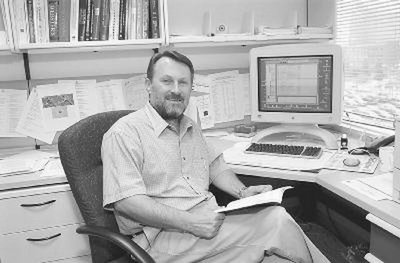May 16, 2002
Age-related macular degeneration
Claire Dietz
HS News & Community Relations
Age-related macular degeneration is a serious, progressive eye disease perhaps best known as the leading cause of legal blindness in people over 55. The process of its development is not well understood and, for the most common form, no effective treatment is available.
Dr. John W. Crabb, the speaker at this year’s Sidney Futterman Memorial Lecture, sponsored by the School of Medicine’s Department of Ophthalmology, is using the current tools of protein science to investigate an important risk factor for age-related macular degeneration (AMD).
Crabb, professor and staff scientist at the Cole Eye Institute and Lerner Research Institute of the Cleveland Clinic Foundation, will speak on “Proteomic Approaches to the Etio-Pathology of Age-Related Macular Degeneration” at 10:30 a.m., Thursday, May 23, in room D-209 of the Health Sciences Center. The lecture is open to everyone.
Crabb has been working on protein structure and protein chemistry for some time before he turned his attention to AMD. This is a disease of the macular region of the eye’s retina. It often develops slowly and affects the cones of the retina, which are responsible for direct, high-acuity vision. Peripheral vision usually remains largely intact, so that people with advanced disease can see light and some motion, but lose the ability to read, recognize faces and drive, among other critical functions.
There are two forms of the disease, one called the “wet” form that involves new blood vessel growth and bleeding behind the retina, and the more common “dry” form, in which the cone-shaped photoreceptor cells of the macular region either degenerate or are impaired in their function.
One of the risk factors for AMD is the presence of “drusen,” spots visible behind the retina in an eye exam. Although most people over 50 have some drusen (the word is the German plural of druse), an increase in their number and/or size is associated with an increased risk of AMD.
Crabb is using laser capture and mass spectrometry, among other tools of protein analysis, to identify the proteins found in drusen and to characterize their modifications by sugars and lipids. These can also signal increased risk for AMD. His investigations may reveal the origins of these deposits and clues to the disease process underway—and prove or disprove theories about what causes this disease.
Crabb, who was at the UW in the 1980s as a postdoctoral researcher, earned a bachelor’s degree from Lewis & Clark College in Portland and his Ph.D. from the University of Kansas, where he began specializing in protein structure determination. He was director of the Protein Sequencing Facility in Bochum, Germany, and then joined the W. Alton Jones Cell Science Center in Lake Placid, N.Y., where he set up a protein chemistry facility and began his research program in vision.
Along with serving on study sections for both the National Institutes of Health and the National Science Foundation, as well as editorial boards, he has been an executive board member and committee chair for the Association of Biomolecular Resource Facilities.
The annual lecture is named for Dr. Sidney Futterman, a member of the UW Department of Ophthalmology faculty from 1966 until his death in 1979. His research on the metabolism of vitamin A in the retina is widely recognized and he received the Friedenwald Award of the Association for Research in Vision and Ophthalmology the year before his death.



